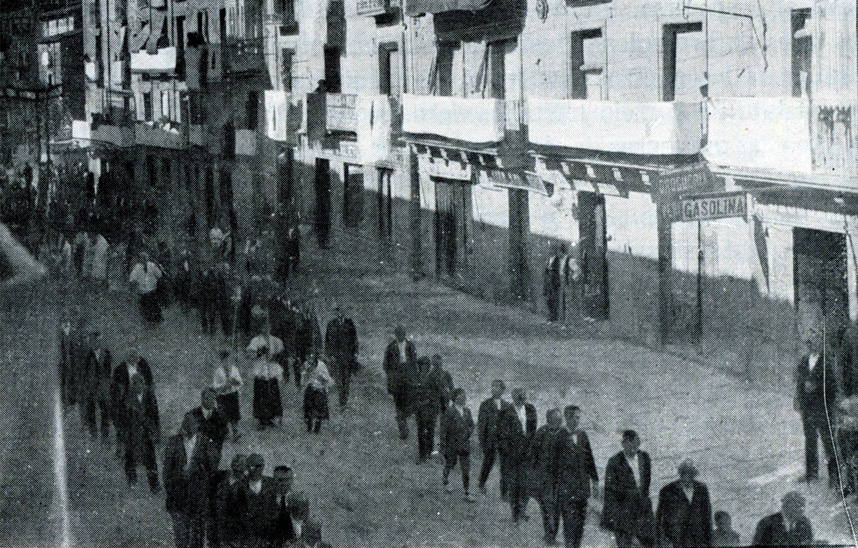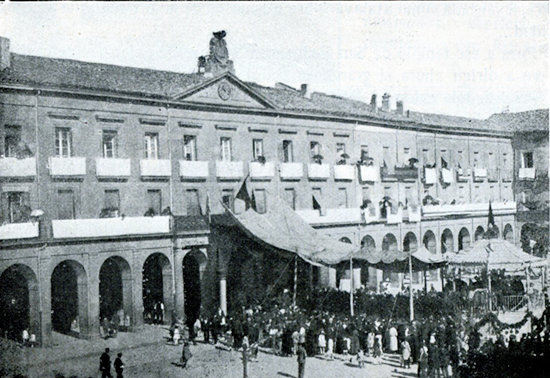Images in Navarra of the III Centenary of the canonization of Xavier (V)

Photo /Procession through the streets of Tafalla. Photo from the Chronicle of the Centenary
From Baztan to France and back to Navarre
A great pathway to travel with the relic of the arm of St. Francis Xavier was scheduled for the Baztan Valley. The destination was the town of Elizondo, where the procession arrived at dusk on September 26th and was greeted with fireworks, a brass band, txistularis, bells and bows. Among the latter, there was one at entrance of the town with the coats of arms of the Valley, Navarra and Javier and another at place of the church as a feudal castle, erected by the Adoración Nocturna (Nocturnal Adoration). In the procession were incorporated the tarsi children with their white tunics, eight heralds or "macericos, richly uniformed in the old style and the kings of arms ...". In the parish church a Te Deum and the particular hymn to the saint composed by the organist Don Juan Berecochea were interpreted.
The following day, a visit was made to the town of the saint's mother, Azpilcueta, where arches were placed with the inscriptions: "Javier, ongi etorria zure amaiñ erritarren arteca", "Azpilkuetak agur" and "Gora dezagun Francisko Javier deuna", as well as a richly decorated and illuminated altar. The Jesuit chronicler affirms that the hand of the Capuchins of Lecároz was clearly visible in all of this. After the mass, the veneration of the relic and the meal, the classic mutil-dantza was danced in honor of the saint.
In Azpilcueta, Father Antonio Astrain bid farewell to the procession, leaving his post as custodian of the relic to the fathers of language vascongada. On the 28th there was a gathering in Elizondo of the towns of Baztan and other neighboring towns with their parish crosses. Father Constancio Eguía put the number of umbrellas at 6,000 and the church was, naturally, too small for so many people and no less authorities. For such an occasion, the best musicians of the valley "fecund in pleasant voices and fine ears" made an effort. In the evening of the same day, September 28, the relic was transferred to Lecároz and the following morning to Elvetea and Narvarte, continuing through the Bidasoa Basin, Cinco Villas and Bertizarana. The tour continued through the French Basque Country, hosted, among others, by the Bishop of Bayonne. From Bayonne, the last French stage, on October 2, he went to Alsasua where many Burundians had gathered to the sound of the chistularis and the choirs of the Capuchins, bells and rockets that "are ejaculatory to the air".
On October 3rd it was the turn of Echarri-Aranaz, Irurzun, Puente la Reina, Mendigorría and Artajona. To the first of the three towns the procession arrived on the third day of their fairs and with this eloquent paragraph the atmosphere is described: "There is no zortzico so pleasant and colorful, nor so joyful frolic in the strikes of the council, of the parish, of the whole valley, as the one that the town of Echarri did in plenary session of the Executive Council, with all the neighbors of the valley of Ergoyena, when they heard that the procession of the Saint was coming. Drummers and bagpipers played the music; then the public followed with their songs". In Irurzun the acts took place outdoors in the fronton. The next stop was in Puente la Reina, where they came from Obanos, Mañeru, Cirauqui and others, and the following ones in Mendigorría and Artajona. In Mendigorría all the women brought the keys of their houses to register under the sponsorship of the saint. In Artajona the procession was received by all its inhabitants with the municipal corporation at the head, four hundred daughters of Mary and one hundred and seventy men with lighted axes, without lacking bows and inscriptions of the saint.
In Tafalla and Olite
The people of Tafalla had been waiting for the relic since five o'clock in the afternoon, but it arrived five hours late, so part of the public dispersed until there was certain news of the arrival and the procession went to the parish of Santa Maria where the relic was kept until the following day, Arellano, Dominican bishop, with a eulogy by Father Janáriz and musical accompaniment by the juniors of high school of the Piarist Piarists. The reliquary arm and the Christ of the Crab were carried in procession from one parish to another by the parish priests of Santa Maria and San Pedro and among the arches erected in the streets, one stands out with this legend: "To the distinguished Apostle from Navarre, Tafalla surrenders its heart".

Arrival of the relic at the Town Hall of Tafalla. Photo from the Chronicle of the Centenary
For the visit to Olite, the civil governor and several deputies went to the town. Together with the municipal corporation with flag, the flags of Miranda de Arga and Larraga joined them. Father Huarte defines the arrival to the city that, by the way, he calls villa: "The entrance in Olite was truly grandiose. Half a kilometer from the town, a huge crowd of people from the two parishes was waiting for us. It is impossible to explain in words what happened there; do not think that what we have just said is an exaggeration. There were nine magnificent arches on the way from entrance of the village to the parish of San Pedro. One of the arches read: "The Merindad of Olite surrenders to the great Crusader of Christ"..... Then countless wreaths, hanging from garlands imitating chandeliers, beautiful, whimsical lanterns, illuminated with electric light..... Then another arch read: "Long live the Arm of Xavier, who could not hold it up because he baptized so much". At night, there was a vigil of the Nocturnal Adoration in St. Peter's, several Masses in the early morning and a transfer to St. Mary's on October 5. Later, the relic was taken to the homes of the sick and at nine o'clock in the morning a procession was organized with the banners of the catechisms, those of the apostolate with the twelve promises and the twenty banners of all the surrounding towns. In the place a solemn pontifical mass took place, celebrated by Bishop Baztán, in which the Second Pontifical of Perosi was interpreted. The regional newspapers Diario de Navarra and El Pensamiento Navarro, as well as El Olitense, in their issues 218 and 219 provide numerous details of the event.
LEARN MORE
Diario de Navarra, October 5, 1922.
EGUÍA RUIZ, C., Reliquias de San Ignacio de Loyola y San Francisco Javier. Su recorrido triunfal por España, Madrid, Blass, S. A. Tipográfica, 1924.
El Olitense, October 5, 1922 and October 22, 1922.
El Pensamiento Navarro, September 21, 27, 28, 1 and 4, 1922.
